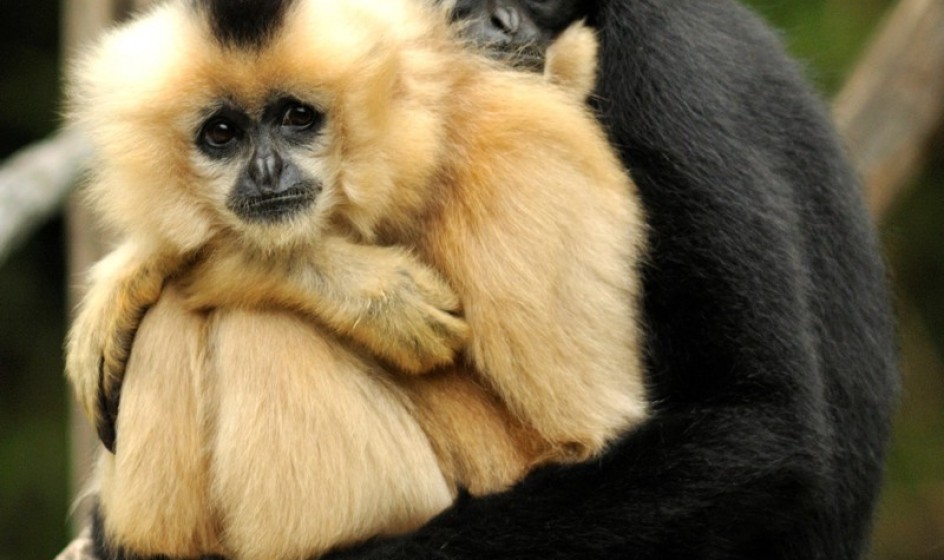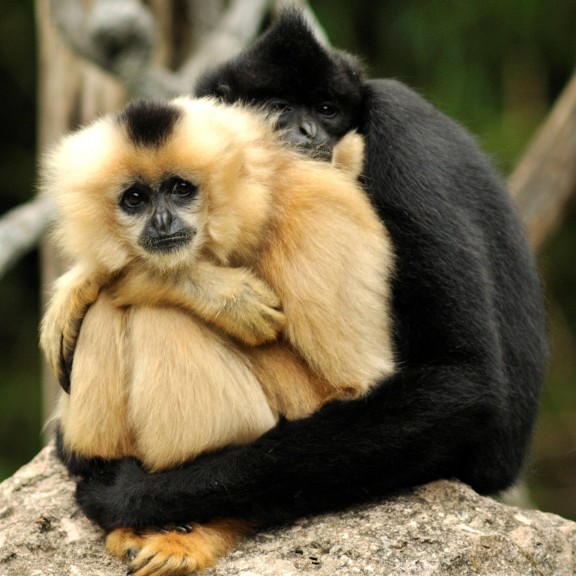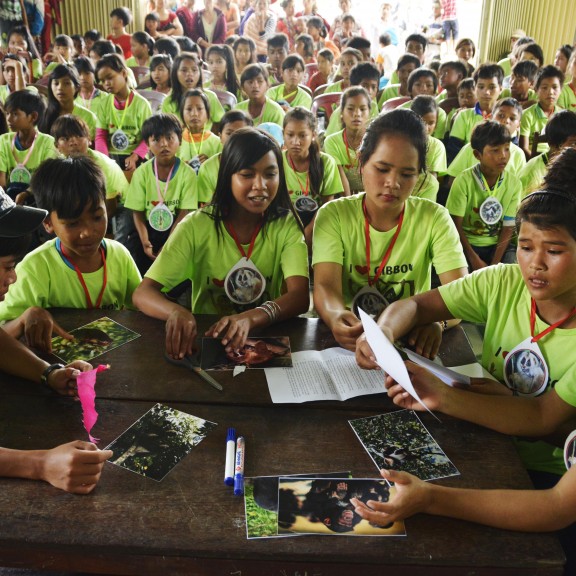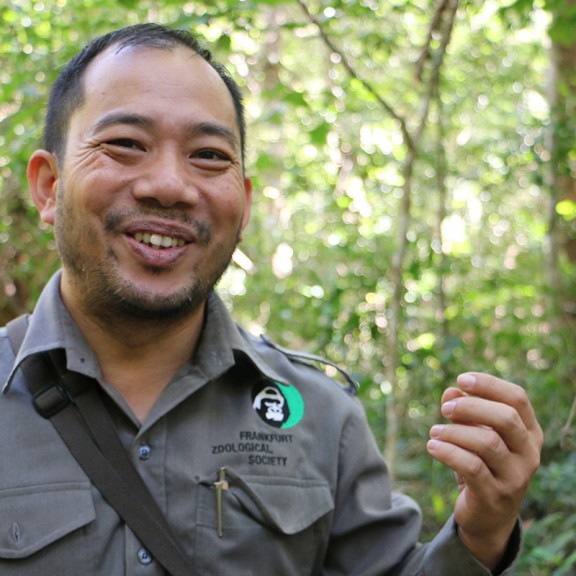

Yellow-cheeked Crested Gibbon
The Voice of Asia’s Rainforests
Their loud and energetically calls are described as some of the finest songs ever heard in the tropical rainforests of Asia. Sometimes they occur as a fascinating solo song that echoes through the forest or as a long duet in the early morning hours. Then they swing on their long arms with remarkable power and grace, moving rapidly from one branch to another, high up in the top of the trees. Here is where they spend their whole life – gibbons are highly specialized forest-dwellers, living high in the forest canopy.
Like all other primate species, gibbons are under very severe threat. The Yellow-cheeked Crested Gibbon (Nomascus gabriellae) too. This species is found in South Vietnam, Laos and north-eastern Cambodia. The Yellow-cheeked crested gibbon owes its name to its distinctive colouration: the males have a black fur with only the cheeks being yellow, whereas the females and the newly born are of a bright yellow colour.
It is little known about the species and there are no real records of how many still exist in the wild. However, due to an estimated population reduction of at least 50% in less than 50 years, the Yellow-cheeked Crested Gibbon is categorised as Endangered by the World Conservation Union (IUCN Red List). Due to severe habitat loss and hunting for meat and the pet trade there are probably just few animals left in the wild and urgent conservation measures are needed to prevent them from extinction.
Implementing Partners



Project Aim
The aim of this project ist protect the gibbon’s natural habitats on the long term by designating a new protected area in Vietnam. The new protected area will maintain and secure a vital and strategic corridor of forest in the Annamite range, connecting Ngoc Linh Nature Reserve and further protected area in Vietnam, Laos and Cambodia, with the Kon Ka Kinh – Kon Cha Rang forest complex to the south. This new protected area will maintain critical habitat/connectivity, helping to assure the survival of the Critically Endangered and endemic grey-shanked douc langur (Pygathrix cinerea) and the highly range restricted and Endangered northern yellow-cheeked gibbon (Nomascus annamensis).
Activities
To achieve the objectives this project will:
- Ensure the an effective protected area boundary, maintaining the ecology of the forest, through surveys, GIS and consultation
- Establish and operationalise a Community Conservation Team (CCT) as a forest protection measure, this should improve urgent crime prevention and fill enforcement capacity gaps
- Improve law enforcement by helping existing forest patrol personal to transition to full Forest Protection Department rangers, via training
- Provide forest management and governance training for existing forest management boards, to support creation and transition to a single protected area management board, which has the appropriate capacity in place to conserve very high biodiversity forest.
- Wildlife trade survey, focusing primarily on primates, in the whole of Kon Plong district and establishing a volunteer network to help maintain monitoring and reporting, and using date to support law enforcement.
- Provide an evidence-based and participatory process to drive/achieve protected area gazettement - that would otherwise not take place - following the required political processes/steps and which will include creation of appropriate sub-national policy(s) – i.e. to underpin protected area gazettement and operations.
The project will support improvements to local livelihoods; it will empower marginalised ethnic minorities to become conservation champions, and help to reduce poverty.
Local Communities
One of the main project objectives ist to support local communities an improve local livelihoods / reduce poverty. Activities include:
- Improve market access
- Training courses on crop diversification, yield maximization, supply chains, marketing and market access
- Village (and household where appropriate) level sustainable landuse plans in the protected area bufferzone
- An eco-stove design and procurement programme to reduce local fuel wood requirements
- Support the development of forest gardens, including the fast growing timber, for local construction uses/fuel, plus shade grown crops & trees
Project Partner / Supporters
Since 2016, a special alliance of now 30 partner zoos has been supporting the Stiftung Artenschutz's commitement to the gibbon conservation in Vietnam . With the funds provided by the partner zoos, Stiftung Artenschutz supports the activities of the local partners.
This alliance was made possible by the British zoo expert and author Anthony Sheridan, who does not only provides a financial support for the project, but also provides advice and assistance.
The project is funded as part of the campaign "Zoo Animal of the Year 2019" ("Zootier des Jahres", in German only) .
Gold Sponsor:
Karlsruhe Zoo, Osnabrueck Zoo
Silver Sponsor:
Aalborg Zoo, Arnheim Zoo, Berlin Zoo, Halle Zoo, Tierpark Hagenbeck Zoo, Hannover Zoo, Heidelberg Zoo,Hellabrunn Zoo, Lithuanian Zoological Gardens, Allwetterzoo Münster, Pairi Daiza, Zoo Praha, Rostock Zoo, Schmieding Zoo, Sóstó Zoo, Wilhelma Stuttgart, Twycross Zoo, Zooverein Wuppertal e.V.
Bronze Sponsor:
Bratislava Zoo, Eskilstuna Zoo, Łódź Zoo, Zoo di Pistoia, Zoo Salzburg, Zoo Warszawa


